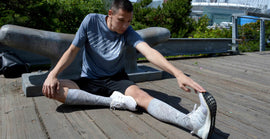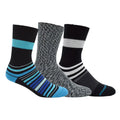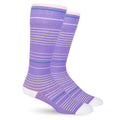3 WAYS TRAVEL COMPRESSION SOCKS ARE HELPING WOMEN AVOID DEADLY BLOOD CLOTS
Posted by ASHLEIGH WESTLE
Why most women need to wear Travel Compression Socks during their travels.
What if I told you that Pregnancy, Birth Control Pills and Hormone Replacement Therapy (HRT) all greatly increase a woman’s risk of developing a life-threatening blood clot or Deep Vein Thrombosis (DVT)) when travelling by air, train, car or bus? And, that the solution to reducing this risk can be as simple as wearing Dr. Segal’s travel compression socks?

You might be thinking, ‘Sorry but, I am too young and too healthy to need to wear Compression Stockings.’ The truth is, being young or healthy has nothing to do with NOT needing to wear them. As young, healthy people become more proactive about their health and show a keener interest in Disease PREVENTION and WELLNESS they are discovering the important connection between blood clots (DVT’s) , HORMONES and COMPRESSION.
The reality is that almost all women between the ages of 16 and 65 are impacted by at least one of these three factors.
Now Ask Yourself, “Are You One of These High Risk Women?”
1. Are you Pregnant?
2. Are you taking Birth Control Pills?
3. Are you on Hormone Replacement Therapy?
1. The Link Between DVT and Pregnancy:
During pregnancy and up to 6 weeks post partum, pregnant women are at a 10x greater risk of developing a DVT due to the following factors:
* Blood clotting factors increase during pregnancy due to an increase in the hormone ESTROGEN.
* Changes in the levels of the hormone PROGESTERONE affect the lining of the vein walls
* As the baby grows, it puts pressure on the Inferior Vena Cava which increases the pressure in the veins of your leg
Long periods of sitting, as experienced during travel combined with the above factors can increase your risk of developing a blood clot which tends to form in the deep veins of the legs.
If you notice swelling, soreness, tenderness or redness in one of your legs, particularly at the back of your lower leg, then this could be a sign of a blood clot.

2. The Link Between DVT and Birth Control:
The hormones that are in birth control pills (synthetic estrogen and progesterone in combination pills) lead to changes in the blood that promote thrombosis, or clotting. Some newer, so-called third-generation, oral contraceptives have been found in some studies to carry a higher risk for blood clots. This makes a conversation with your doctor about your risk factors and the pros and cons of specific brands of birth control a smart idea. travel compression socks
Take for example the tragic story of Anna Frutiger, a 23 year old dental student who was admitted to the hospital with a pulmonary embolism. Anna didn’t fit the typical picture of a person who would develop a deep vein thrombosis. But she did have an important risk factor: She was taking hormonal birth control pills.
Read ‘DVT and Birth Control: Anna Frutiger’s Story.’
Like birth control and pregnancy, the hormones that are in HRT (synthetic estrogen and progesterone) lead to changes in the blood that promote thrombosis, or clotting. Therefore, women on HRT need to understand the influence HRT has on developing blood clots and its associated risks. With this information, women on HRT can take the necessary precautions to prevent a deadly blood clot from forming.
WHAT ARE THE RISKS?
– Oral HRT (combined estrogen and progesterone, and estrogen-only) increases the risk of venous thromboembolism (VTE) and pulmonary embolism.
– The risk of VTE is increased two to three times with oral HRT. travel compression socks
– These risks increase with age and with other risk factors, such as obesity, previous thromboembolic disease, smoking, and immobility.
– The type, dose and delivery system of both estrogen and progesterone influence the risk of thromboembolic disease.
– The VTE risk appears to be higher among users of estrogen plus progestogens than among users of estrogens alone. In addition, there is evidence for a deleterious effect of medroxyprogesterone acetate on VTE risk.
– Current use of oral estrogens increases the risk of VTE, especially during the first year of treatment, but past users of hormone therapy have a similar risk as never-users. However, transdermal estrogens are thought to be safe with respect to thrombotic risk.
What is Deep Vein Thrombosis?

Deep vein thrombosis (DVT) occurs when a blood clot (thrombus) forms in one or more of the deep veins in your body, usually in your legs. Blood clots occur when blood thickens, sticks together and can no longer move freely. This reaction is often brought on by prolonged periods of immobility (sitting or standing). If this occurs, it can be extremely life threatening as the blood clot can travel to your lung and cause a pulmonary embolism.
According to the American Society of Hematology, of the 400,000+ American’s that will get DVT every year, around 1/3 will die. Women who are pregnant, on birth control, or on HRT are especially at risk of developing a DVT on long-haul flights and long car rides and should definitely consider wearing compression socks when travelling.
The Symptoms of DVT (Blood Clots in Your Legs):
It is very important to understand the symptoms of DVT because if left ignored, can lead to sometimes fatal complications.
– Swelling in the affected leg, including swelling in your ankle and foot.
– Pain in your leg; this can include pain in your ankle and foot. The pain often starts in your calf and can feel like cramping or a charley horse. It won’t go away with regular stretching, massaging or rest.
– Warmth over the affected area. travel compression socks
– Changes in your skin color, such as turning pale, red or blue or purple.
How Long-Flights and Car-Rides Increase Incidences of Blood Clots
Flight related DVT is a condition which has been dubbed “economy class syndrome” by researchers, who believed that there was a link between DVT and long-haul air travel in cramped conditions. This is due to the long periods of sitting in the same position without regular mobility. When we are travelling, our blood pools in our feet and calves, warms up and begins to thicken. The thickened blood can collect in the veins and form a blood clot which could travel to the lungs where it could cause a blockage resulting in a pulmonary embolism.
According to Patient.co.uk, research studies suggest that there is 1 DVT for every 4,656 flights that last for four hours or more. The longer the flight or trip, the more likely you are to get a DVT. To get more detail on the relationship between long-flights/trips and DVT, read our blog post: "Travelling Rituals: The Flight".
Compression Socks: Helping Women Reduce the Risk of Developing a Deadly Blood Clot during Travel.
Women everywhere are wearing Dr. Segal’s fashionable compression socks on long flights and car rides to prevent blood clots, decrease swelling and improve comfort.

Take a look at stylish travel blogger of Point and Pixie Dust blog wearing our Gray/White Travel Compression Socks on her long flight to Phoenix, Arizona. travel compression socks
In her blog post ‘Dr. Segal’s Luxury Compression Socks‘ she states, “[Wearing Dr. Segal’s Compression Socks] was like the difference between flying in coach (gets the job done, totally fine, can be fun) and flying in First Class (you look forward to the experience, and the relaxation and enjoyment of your vacation starts with the flight).”
Before I Go!
Deep Vein Thrombosis (DVT) and Pulmonary Embolism (PE), collectively known as venous thromboembolism, is highly preventable. Wearing stylish graduated travel compression socks when you fly or travel for long periods (4 or more hours) will help keep your circulation flowing and prevent blood from pooling in your legs and feet. If you have any of the risk factors mentioned above, it would be wise to wear Dr. Segal’s travel compression socks on your journeys.
Important TIP: Put our travel compression socks on before you get out of bed in the morning and keep them on until you go to bed after your flight.
Don’t Worry About NOT Looking Good!
We Make Fashionable #CompressionSocks That You’ll LOVE Wearing!
Head over to our online store to find a style that suits you best: https://www.drsegals.com/
If you live in the USA, you can purchase our socks on Amazon: Click here to BUY NOW

We would really appreciate it if you shared this post on Facebook with your friends. There is a lot of important information that is relevant to your inner circle.
#sockswithbenefits
wear. share. win.
Dr. Segal’s
TAGS:
SHARE:




































